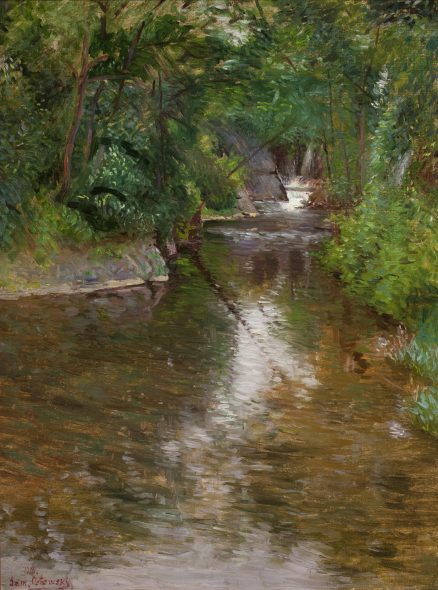- Categories
- Immigrant artists
- Landscapes
- Zoom in on Artwork
- Print Page
- Email Page to Friend
Samuel Ostrowsky’s image encloses the viewer in a woodland setting as observed from the middle of a sheltered stream fringed with foliage. Although the crowded vertical composition shuts out the horizon, shafts of light penetrate the trees, and a bright sky is reflected on the water’s rippled surface. Ostrowsky’s intimate rendering combines straightforward naturalism with the rapid, broken brushwork typical of impressionism and suggestive of on-site execution.
Ostrowsky probably made the painting, one of his earliest extant works, in the rural Hudson River Valley, where, in the summer of 1916, he painted near the hamlet of Milton, New York, on the river’s western shore. The resulting landscapes were featured in a solo exhibition at a Chicago gallery the following September. This work, whose original title is unknown, may well have been included in that show. In her enthusiastic review in the Fine Arts Journal, Evelyn Marie Stuart compared Ostrowsky to nineteenth-century American landscape painter George Inness, who had preceded him at Milton: “But whereas the latter was essentially a reflective painter, Ostrowsky is an emotional and spontaneous one.”i The comparison was particularly relevant for art-lovers in Chicago in 1916: five years earlier, Edward Burgess Butler had made a well-publicized gift to the Art Institute of his collection of numerous Inness paintings.
Between 1912 and the outbreak of World War I, Ostrowsky was in France, painting rural landscapes while studying at the Académie Julian in Paris. At that early stage of his career he admired the works of French Impressionist masters, whose influence is evident here in his application of paint in distinct small dabs of color. On the other hand, in working in the Hudson River Valley, site of a legendary “school” of American landscape painting, the Jewish, Russian-born Ostrowsky may have sought to associate himself both with a native art tradition and with native scenery at a time when Americans were turning away from the seeming corruption of a Europe engulfed by war.
Wendy Greenhouse, PhD
Donated by M. Christine Schwartz to The Richard H. Driehaus Museum, Chicago, Illinois, in 2022
i Evelyn Marie Stuart, “An Atmospherist and His Art,” Fine Arts Journal 34 (Sept. 1916): 418.
